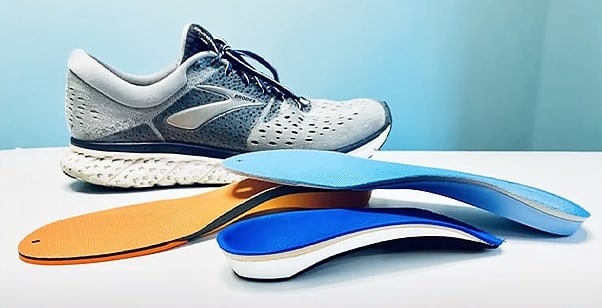Cary Orthopaedics physical therapist Chad Moses (PT, Cert. DN/SMT, GTS, CKTP, Dip. Osteopractic) produces our Patient Education Series to inform patients about various physical therapy modalities and techniques. We hope these videos and article will help answer your questions about custom orthotics. Please contact our office to schedule an appointment to find out if foot orthotics are right for you.
What are custom orthotics?
Custom orthotics are specially molded shoe inserts that support and align the feet. The design is unique to each individual based on their foot structure and biomechanics.
Unlike over-the-counter insoles, custom orthotics are prescribed by a healthcare professional. Your trained physical therapist crafts orthotics after performing a detailed assessment of your foot shape, gait and specific medical conditions.
What do you use custom orthotics to treat?
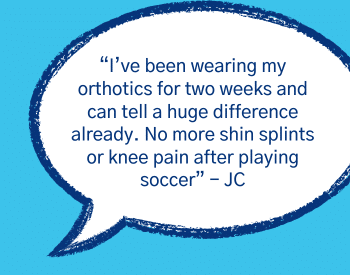 Orthotics can treat a variety of foot, ankle and lower body conditions by providing support, proper alignment and pressure relief. Some conditions they are used for include:
Orthotics can treat a variety of foot, ankle and lower body conditions by providing support, proper alignment and pressure relief. Some conditions they are used for include:
- Plantar fasciitis
- Flat feet
- High arches
- Bunions
- Heel spurs
- Metatarsalgia
- Achilles tendonitis
- Ankle instability
- Shin splints
- Patellofemoral pain (runner’s knee)
- Hip pain
- Lower back pain
How do custom orthotics differ from standard, over-the-counter orthotics?
Custom orthotics differ from over-the-counter (OTC) insoles in several ways, including design, fit, materials and effectiveness.
1. Personalization & Fit
Custom Orthotics: Made especially for an individual’s foot structure and biomechanics based on a detailed assessment (e.g., foot scans, molds or gait analysis). They address specific medical conditions.
OTC Insoles: Mass-produced and come in standard sizes. They provide general support but don’t accommodate unique foot shapes or medical needs.
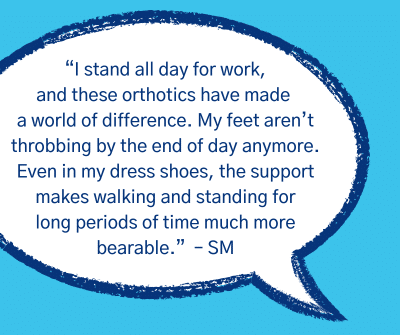 2. Function & Effectiveness
2. Function & Effectiveness
Custom Orthotics: Designed to correct biomechanical issues like overpronation, high arches or misalignment, potentially improving posture and relieving pain in the feet, knees, hips and back.
OTC Insoles: Provide cushioning and basic arch support but don’t correct structural or alignment problems.
3. Materials & Durability
Custom Orthotics: Made from high-quality, durable materials (e.g., rigid plastic, carbon fiber or specialized foams) that provide long-term support and last several years.
OTC Insoles: Typically made from softer, less durable materials like gel or foam, which wear out faster (usually within months).
4. Medical vs. General Use
Custom Orthotics: Prescribed by a healthcare professional (podiatrist or orthopedist) for specific conditions such as plantar fasciitis, arthritis or diabetic foot issues.
OTC Insoles: Designed for general foot discomfort, shock absorption or mild support in everyday activities.
5. Cost
Custom Orthotics: More expensive (typically $200 to $600) due to their personalized design and long-lasting materials. Most insurance companies will cover part of the cost.
OTC Insoles: More affordable (usually $20 to $60) but may need frequent replacement.
Bottom line: Custom orthotics are the better choice if you have a diagnosed foot condition, chronic pain or alignment issues. OTC insoles are a budget-friendly alternative if you only need mild support or cushioning.
What is the process of creating custom orthotics?
The process for creating custom foot orthotics involves several steps to ensure they are tailored to an individual’s unique foot structure and needs. Here’s what to expect:
1. Initial Consultation & Assessment
A physical therapist evaluates your feet, gait and posture. You’ll discuss any pain, medical conditions or specific activities (e.g., sports, work-related standing) with which you are having difficulties.
2. Foot Scanning or Casting
A plaster mold or 3D scan is taken to create an exact replica of your feet. This ensures the orthotics will provide proper alignment and support.
4. Custom Design & Manufacturing
The scan or mold is sent to a specialized lab, where technicians craft the orthotics based on your needs. Materials (rigid, semi-rigid or soft) are chosen depending on your foot condition, activity level and footwear type. This process can take 2 to 3 weeks.
5. Fitting & Adjustments
Once the orthotics are ready, you return to your physical therapist for a fitting. The provider checks for comfort, support and any pressure points. Minor adjustments may be made to ensure a perfect fit.
6. Break-In Period & Follow-Up
You gradually break in the orthotics over 1 to 2 weeks to allow your body to adjust. A follow-up visit may be scheduled to address any discomfort or necessary modifications.
7. Long-Term Use & Maintenance
Custom foot orthotics typically last 2 to 5 years with proper care. They may need periodic adjustments if your foot structure changes.
This personalized process ensures that the orthotics provide maximum comfort, support and pain relief.
How do digital and plaster orthotics differ?
Custom orthotics can be created using digital scanning or plaster casting. Each method has its pros and cons. Here’s a comparison:
Digital orthotics (3D scanning, CAD-CAM)
Pros:
- Faster process: Scanning takes minutes, and digital files are immediately sent for fabrication.
- More precise: Advanced scanners can capture foot contours with high accuracy.
- Easier adjustments: Modifications can be made digitally before production.
- No mess: 3D imaging requires no plaster or physical molds.
Cons:
- Scanner quality varies: Some scanners may not capture specific foot abnormalities as precisely as plaster molds.
- Lack of manual control: Some physical therapists prefer the hands-on feel of a physical mold to detect subtle deformities.
- Expensive equipment: Clinics need high-quality scanners and software, which can increase costs.
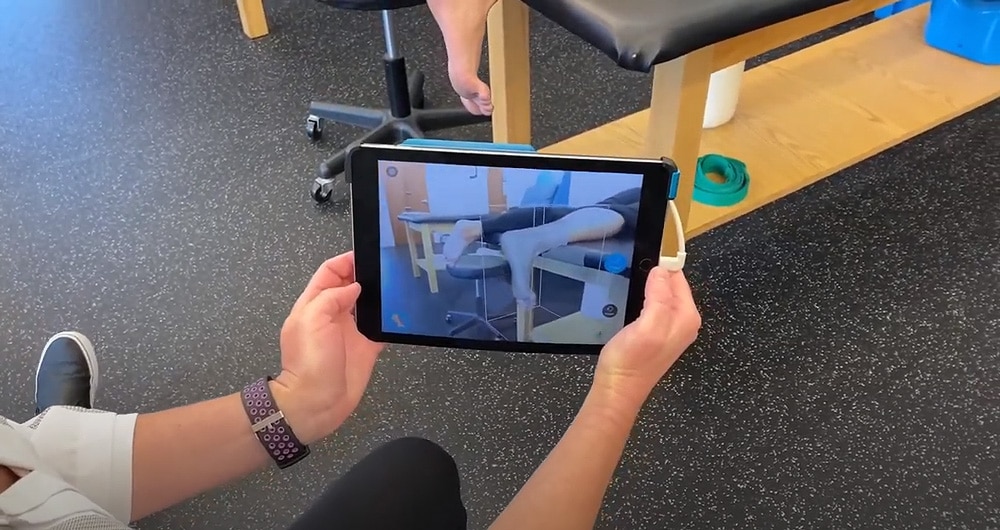
Plaster orthotics (traditional casting)
Pros:
- Highly customized: Plaster molds capture even subtle foot details, including deformities.
- Better for complex cases: Ideal for severe foot conditions like diabetic ulcers or rigid deformities.
- Trusted method: Creating a mold is the gold standard many physical therapists prefer because of the hands-on approach.
Cons:
- Time-consuming: Casting, drying and shipping take longer than digital methods.
- Messy process: Requires plaster application and removal.
- More prone to human error: Any movement during casting can affect accuracy.
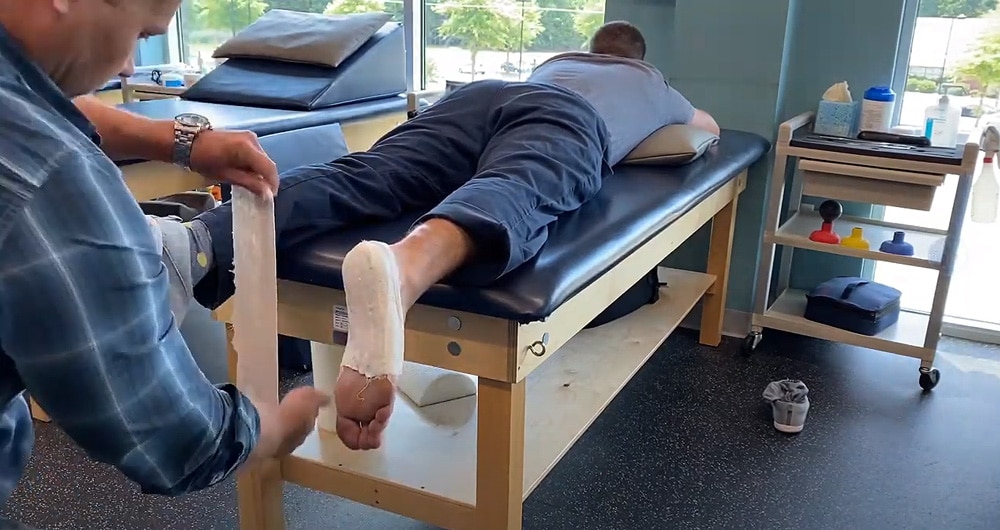
Which Is better?
For most patients, digital scanning is faster, cleaner and more precise for general orthotic needs. However, plaster casting may be better for complex cases, such as extreme foot deformities or cases needing ultra-customized modifications.
Who makes custom orthotics in the Triangle?
At Cary Orthopaedics, our goal is to restore your foot health. Our physical therapists are trained to provide orthotic devices to address your unique foot pain. We offer both plaster and digital options for the best custom-fitted orthotics.
Want to know more? In this episode, physical therapist Kristen Reinhard (PT, DPT) discusses custom foot orthotics.

